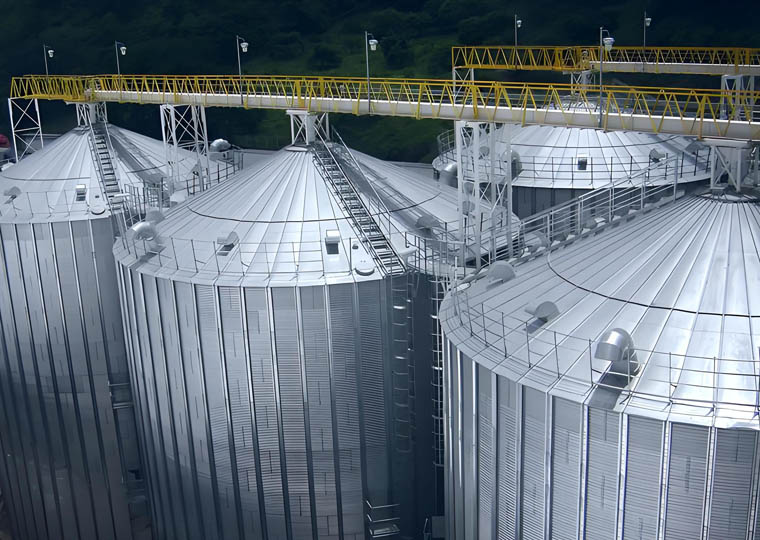Grain silos, especially steel silos, as an important facility for modern grain storage, have been widely used around the world due to their advantages such as light deadweight, short construction period, high automation and high efficiency. However, due to the characteristics of thin cylinder walls and deep grain layers, steel plate silos also face some challenges in the process of using them, such as condensation, arching, mold and other problems. Therefore, when using grain silos, attention must be paid to the following aspects to ensure the safety of grain storage.

First, strict control of grain moisture and impurities
Grain moisture and impurities is the key factor affecting its safe storage. Excessive moisture and impurity content will not only reduce the quality of grain, but also may trigger mold and pests. Therefore, before the grain is put into the warehouse, its moisture and impurity content should be strictly controlled. Generally speaking, grain moisture should not exceed 13%, and impurity content should be controlled below 1.0%. If the grain moisture exceeds 13.5%, ventilation and cooling measures should be taken in a timely manner in order to reduce grain moisture and prevent mold.
Second, strengthen the grain silo ventilation and dehumidification
Due to the thin wall of the steel plate silo, the temperature difference between the inside and outside is large, easy to trigger the phenomenon of grain condensation. Condensation will not only lead to a decline in grain quality, but also may cause mold and insect pests. Therefore, in the use of grain silos, ventilation and dehumidification should be strengthened. On sunny days, natural or mechanical ventilation should be utilized to discharge the moisture and heat in the grain silo and reduce the temperature and humidity in the silo. At the same time, the installation of axial fans or exhaust devices at the top of the silo, the bottom of the silo to install mechanical ventilation is also effective in preventing grain condensation measures.
Third, improve the grain inspection system, timely detection and treatment of problems
Grain inspection system is an important means to ensure the safety of grain storage. Through the installation of temperature and humidity sensors, real-time monitoring of temperature and humidity changes in the grain silo, timely detection and treatment of grain heating, condensation and other issues. Once the grain temperature or humidity is found to be abnormal, measures should be taken immediately, such as ventilation and cooling, dehumidification, etc., in order to prevent further deterioration of the problem.
Fourth, follow the principle of first-in-first-out, timely circulation of grain
In order to avoid the grain in the warehouse for a long time lead to quality degradation, should follow the first-in-first-out principle, timely circulation of grain. Through regular rotation of grain, not only can maintain the freshness of grain, but also timely detection and treatment of problems in the process of grain storage.
Five, strengthen the grain bin sealing and insulation measures
The sealing and insulation of grain silos is crucial to the safety of grain storage. Good sealing of the grain silo can effectively prevent the outside world moisture and pests invasion, to maintain the grain silo dry and clean. At the same time, thermal insulation measures can reduce the temperature difference between the inside and outside of the grain silo and reduce the possibility of grain condensation. Therefore, in the process of use, should regularly check the sealing and insulation of grain silos, timely repair of damaged seals and insulation.
Sixth, improve the management level of grain storage
In addition to the above measures, improve the level of grain storage management is also the key to ensure the safe use of grain silos. This includes strengthening the training and education of grain storage management personnel, improve their professional quality and operational skills; establish a perfect grain storage management system and process, to ensure that the measures are effectively implemented; strengthen the maintenance and repair of grain storage equipment, to ensure its normal operation and functioning.
In summary, grain silos need to pay attention to a number of aspects in the use of the process, including strict control of grain moisture and impurities, strengthen the silo ventilation and dehumidification, improve the grain inspection system, follow the principle of first-in-first-out, strengthen the silo sealing and heat preservation measures as well as to improve the level of management of grain storage and so on. Only by doing this can we ensure the safe use of grain silos and guarantee the safety of grain storage.
Leave a Reply